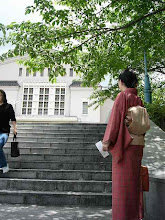However, this temple is not a 'sightseeing temple.'
Advanced reservations required by a Japanese reply postal card. So if you're not a resident in Japan, you'd better ask a travel egency to make a reservation for you.
(If you want to do it by yourself, let me know. I can tell you how to. :D )
And admission fee @3,000 yen per person (30USD) is not cheap. This includes a fee to join a Buddhism ceremony to chant & copy Buddhist sutra. At this temple, joining the ceremony is of principal importance and seeing the garden comes in the second place.

Well, let me tell you a little bit of the history of this temple.
Although there's a lack of any conclusive evidence, but it is said there used to be a villa of Prince Shōtoku in the early 7th century. And about 100 years later, Priest Gyoki , who exerted himself for construction of the Great Buddha of Nara, founded a temple of Hoso sect in 8th century.

It was devastated in 14 century, but a famous landscaper Muso Kokushi refurbished it in 1339.
Now it is said that more than 120 species of moss are flowing over the ground in the central garden.
The amazing thing is....

...it was never planned to be covered in moss.
It is considered this scenery was born in 18th to 19th century. Now we can enjoy what Muso Kokushi could not see or imagine. ;P
The garden of Saihoji Temple is divided into two parts. One the circuit-style with woods and pond while the other is the stone garden style.

The circuit-style part has a pond in the shape of '心(kokoro)' , the Chinese character meaning 'heart' or 'mind'. So carefully watching this garden may lead you to reexamine yourself.

The stone garden is halfway up a hill.
And this is thought to be the first dry garden in Japan.
All the Japanese stone gardens including the famous rock garden at Ryoan-ji may not be seen without this garden as an example.
This garden is said to signify the water flow of waterfalls. Can you imagine that??
















